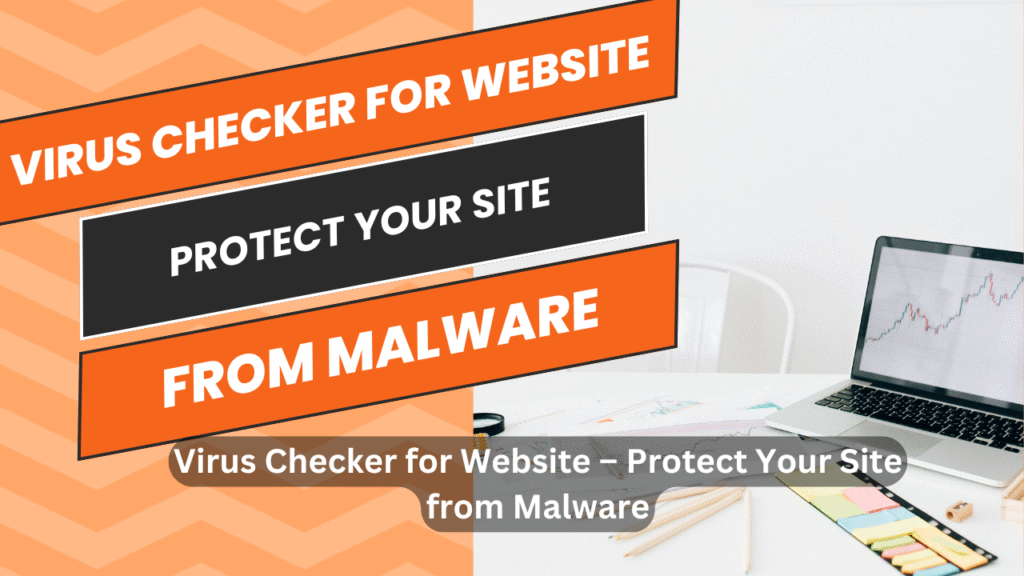Website Malware Scanner – Safeguard Your Site from Threats
If you’re running a website, here’s something that’s not talked about enough: your site might be infected and you wouldn’t even know it and you’ll need Virus checker for website in that case.
Malware doesn’t always come crashing through the front door. Sometimes it slips in quietly, hides in the background, and causes real damage over time. From weird redirects to stolen customer info, it can get messy fast — and if Google catches it before you do, your site might get flagged or completely blacklisted.
That’s why running a website virus checker is something every site owner should be doing — not once in a while, but regularly.
Every day, over 30,000 websites fall victim to some form of cyberattack. Imagine waking up to find your site defaced, your customer data stolen, or your search ranking gone. That’s the harsh reality for many site owners. Website malware, a broad term for malicious software like viruses, Trojans, and ransomware, can sneak onto your site in many ways. It often hides in outdated software, weak passwords, or bad code. But there’s good news. A virus checker for websites acts as your first line of defense. It helps you find and fix these hidden threats before they do serious harm.
Why Malware Is a Big Problem (Even for Small Sites)
A lot of people think malware only targets big websites or popular blogs. But that’s not true. In fact, smaller websites are often easier targets because they usually don’t have strong security in place.
Here’s what malware might do to your site:
- Redirect visitors to sketchy pages
- Add spam links across your pages
- Steal user data through hidden scripts
- Get your domain blacklisted by search engines
- Slow down or crash your server
- Install backdoors for repeated access
And the worst part? You might not notice it until your visitors start complaining or your traffic vanishes overnight.
Common Malware Vectors and Vulnerabilities
Many malware attacks use simple entry points. Old software is a big risk. If your website’s platform, like WordPress or Joomla, isn’t updated, hackers can use known flaws to get in. The same goes for old plugins, themes, and even your server software. These unpatched spots are like open doors for attackers.
Weak passwords make it easy for criminals. They use special programs to guess common passwords over and over. If your site has simple login details, it can be broken into quickly. Strong, unique passwords are a must for every user account.
Bad coding practices also create holes. Issues like SQL injection let attackers steal data from your database. Cross-site scripting (XSS) can inject bad code into your site, harming your visitors. These coding errors become easy targets for skilled hackers.
How a Website Virus Checker Works
Scanning and Detection Mechanisms
A website virus checker uses smart tools to find trouble. One way is signature-based scanning. This method looks for known malware “signatures” or specific code patterns. It’s like checking fingerprints against a database of known criminals. When a match is found, the scanner flags it as a threat.
Heuristic analysis is another key method. This approach looks at how code behaves, not just its known pattern. It can spot new or changed malware that no one has seen before. If a file acts strangely, like trying to connect to a suspicious server, the checker will alert you.
Virus checkers also use blacklist monitoring. They check your site’s IP address and domain against lists of known bad actors. If your site suddenly appears on one of these blacklists, it’s a strong sign of infection or compromise. This helps protect your reputation and search ranking.
Real-Time vs. Scheduled Scans
Do you want constant watch or regular checks? Many virus checkers offer both. Real-time protection means your site is watched every second. If new malware appears, it’s caught right away. This gives you immediate peace of mind.
Scheduled scans are also vital. These run at set times, like daily or weekly. They do a deep dive into your entire site. This helps catch threats that might have been missed or slipped in between real-time checks. It ensures a thorough cleanup.
You can also run manual scans. If you suspect an issue or make big changes to your site, an on-demand scan helps. This gives you control to check things whenever you need to.
What Does a Website Virus Checker Actually Do?
Think of it as a health check for your site. A website virus checker scans your site’s code, files, and links to see if anything suspicious is hiding under the hood.
These tools look for:
- Known malware patterns
- Unusual redirects or scripts
- Blacklisted domains
- Injected spam or phishing links
- Modified core files
Some tools even tell you if your site is listed on Google’s blacklist or flagged for suspicious activity.
Choosing the Right Website Virus Checker
Key Features to Look For
When picking a virus checker, certain features stand out. First, look for a high malware detection rate. You need a tool that can find a wide range of threats, not just the common ones. Accuracy is key to keeping your site clean.
Scan speed matters too. A slow scanner can drag down your website’s performance. Pick a tool that runs fast without making your site sluggish. Efficiency keeps your visitors happy.
Ease of use is crucial. The tool should be simple to set up and manage. You don’t want a complex system that needs a tech expert to operate. Look for clear dashboards and easy-to-understand reports.
Automated removal and remediation are big time-savers. Some tools can automatically clean up infections. This means less manual work for you and faster recovery after an attack. Cloud-based solutions are often easier to use. On-premise options give more control but need more setup.
Popular and Reliable Virus Checker Solutions
Many good virus checker solutions exist today. Tools like Sucuri, Wordfence, and SiteLock are widely known for website security. Malwarebytes also offers strong protection. Each has its own strengths, like focusing on WordPress or offering advanced firewall features.
Your website type also matters. A small blog might do well with a free or low-cost solution. An e-commerce store, handling customer payments, needs top-tier protection. Big enterprise sites often need custom solutions with deeper security checks. Think about your site’s size and what it does.
Free Tools You Can Use to Scan Your Website Right Now
You don’t need to spend a fortune to find out if your site is infected. There are plenty of free and reliable tools out there:
🛠 Google Safe Browsing
Checks if Google considers your website unsafe.
👉 https://transparencyreport.google.com/safe-browsing/search
🛠 Sucuri SiteCheck
One of the most popular free website scanners.
👉 https://sitecheck.sucuri.net
🛠 VirusTotal
Paste your URL and see results from dozens of antivirus engines.
👉 https://www.virustotal.com/gui/home/url
🛠 Quttera
Scans for malware, suspicious code, and security risks.
👉 https://quttera.com
🛠 WPScan (WordPress-specific)
Great for checking if your plugins or themes have known vulnerabilities.
👉 https://wpscan.com
These tools are simple, free, and give you a quick idea of what’s going on.
Real Talk: Signs That Your Website Might Be Infected
Sometimes it’s obvious. Other times, it’s sneaky. Watch out for:
- Your site redirecting to another one
- Random ads or pop-ups showing up
- Strange users or files in your admin panel
- Major drop in traffic (especially from Google)
- Pages loading slowly or crashing
- Browser warnings or blocked access
If you spot any of this, it’s time to check your site immediately.
What We Do at WpPiP (and Why It Works)
We’ve worked with businesses that didn’t even know their website had a problem until it was almost too late. Our approach is hands-on — no cookie-cutter solutions here.
Here’s what we offer:
- Manual + automatic malware scanning
- Full malware removal and code cleanup
- Secure backups and restoration
- Real-time monitoring and alerts
- Setup and configuration of security tools
- WordPress hardening
- Ongoing support and peace of mind
If your website’s already infected, we can help. If it’s clean, we’ll help keep it that way.
10 Quick Ways to Make Your Site Safer Right Now
Want to avoid most common attacks? Start here:
- Keep your software, plugins, and themes updated
- Use strong, unique passwords
- Set up a firewall or security plugin
- Enable two-factor login
- Take regular backups
- Limit admin access
- Use HTTPS (SSL)
- Avoid nulled/pirated plugins and themes
- Don’t allow file uploads unless absolutely needed
- Scan uploaded files (like zip folders or PDFs)
Use tools like Google Safe Browsing or Sucuri to scan it. They’ll tell you if it’s flagged.
Yep. Google constantly scans and flags infected or risky websites.
Use plugins like Wordfence or external tools like VirusTotal and Sucuri.
Yes. Upload it to VirusTotal before adding it to your site.
More common questions:
1. What do I do if my website is hacked?
Stop everything, disconnect access, run a malware scan, and call an expert (like us).
2. Can I fix a hacked site myself?
Maybe — if you know what to look for. Otherwise, it’s easy to miss something.
3. Are there truly free website scanners?
Yes, like Sucuri and Quttera. They give solid results.
4. What’s a backdoor on a website?
It’s a secret way hackers leave behind to come back later. Nasty stuff.
5. How often should I check for viruses or malware?
Weekly at the very least. More if your site gets a lot of traffic.
6. Will antivirus software on my computer catch website malware?
Nope. Antivirus protects your device — not your site. You need a web scanner.
7. Can file uploads bring in viruses?
Yes. Always scan uploads and restrict file types.
8. How can I tell if my site is blacklisted?
Use Google Safe Browsing or tools like Sucuri. If flagged, browsers may block your site.
9. Is malware the same as a virus?
Not exactly. A virus is one type of malware. There are many kinds.
10. Is SSL (HTTPS) enough to protect my website?
No. It only protects data in transit. You still need active security.
11. Can old plugins open the door to hackers?
Absolutely. Outdated plugins are a top reason for infections.
12. Can I scan a WordPress theme before using it?
Yes. Upload it to VirusTotal or use a plugin like Wordfence to check.
13. Can I scan my entire hosting server?
Some hosting providers let you do this. Or you can use tools like Imunify360.
14. Can I check someone else’s site for malware?
Sure. Tools like Sucuri or VirusTotal are public and free.
15. What’s a WAF?
Web Application Firewall. It blocks bad traffic before it hits your site.
16. Do security plugins slow down websites?
Some might — but good ones are worth it. Just don’t overdo it with too many.

